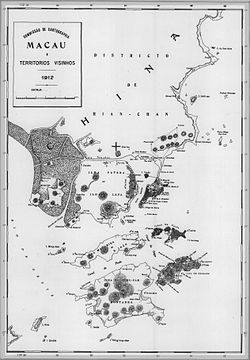 |
| Geography of Macau |
|---|
| Other Macau topics |
| Macau Portal |



There is one main peninsula, one main island, and several smaller peninsulas, islets, and artificial islands in the Macao Special Administrative Region. The main island is located to the south of the Macau Peninsula and to the east of Hengqin Island of the Pearl River (Zhujiang), Guangdong Province, China. The island has remained unnamed since its creation in the late 1990s, after the reclamation project of Cotai, which filled up the channel between the islands of Coloane and Taipa.
Contents
Historically, Coloane and Taipa were under the administration of the Concelho das Ilhas, which was abolished in 2001.
The Macau Peninsula was once an island in the Pearl River Delta. It has been linked to Zhongshan Island as a result of sedimentation and became a peninsula approximately two thousand years ago. Apart from this case, all of the Macanese former islands were merged either directly or indirectly with the Macau Peninsula or the newly unnamed island directly as the result of artificial land reclamation.